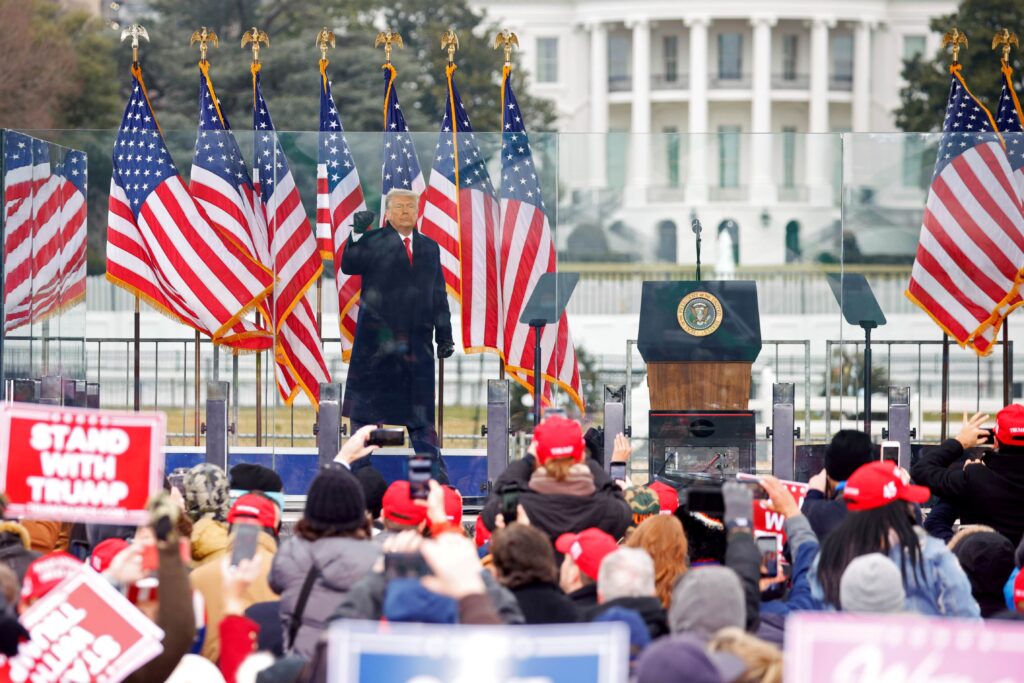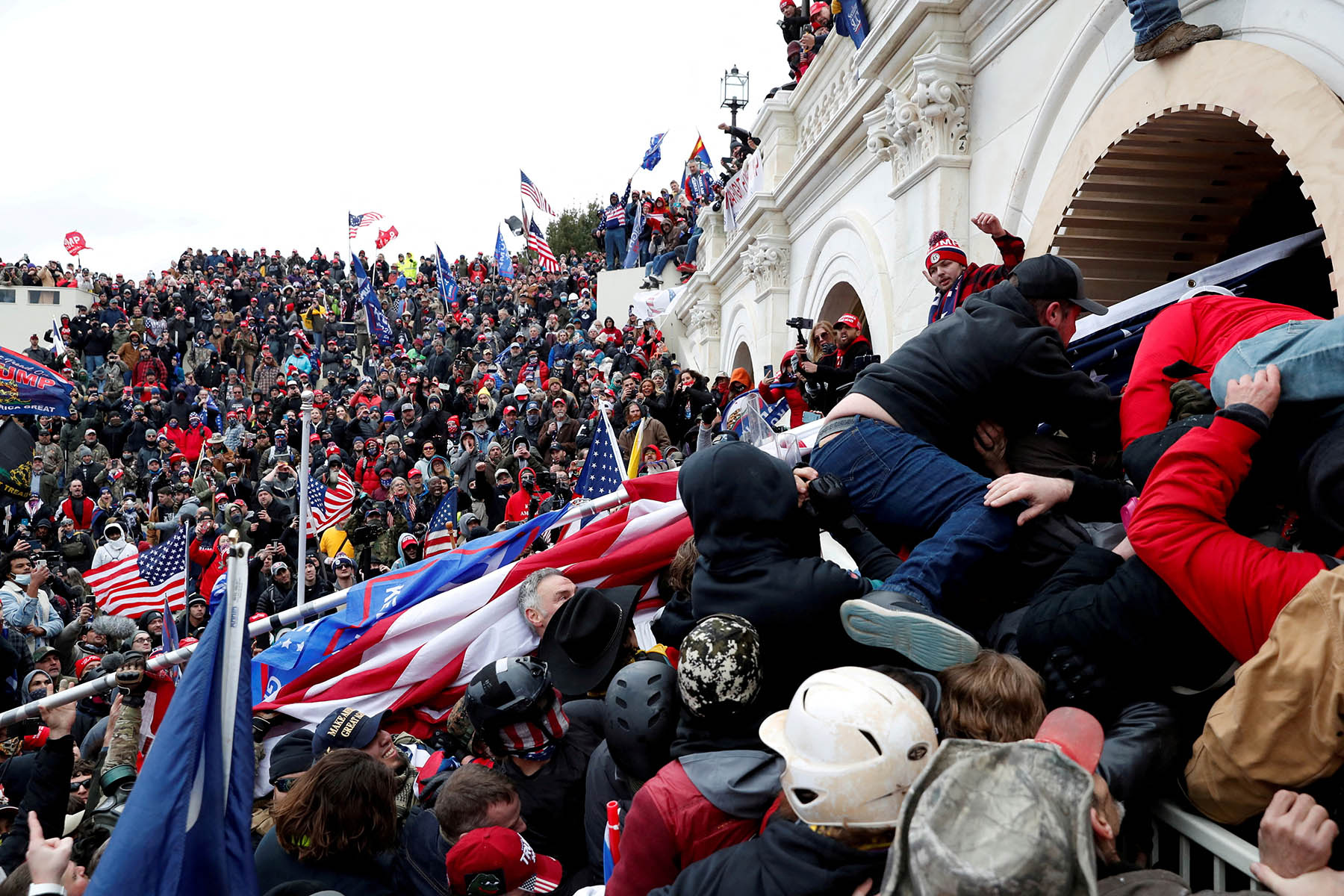DENVER (AP) — In the summer of 2020, Gerard Magliocca, like many during the coronavirus pandemic, found himself stuck inside with time on his hands.
A law professor at Indiana University, Magliocca emailed with another professor, who was writing a book about overlooked parts of the Constitution’s 14th Amendment. He decided he would research the history of two long-neglected sentences in the post-Civil War addition that prohibit those who “engaged in insurrection or rebellion” from holding office.
Magliocca posted a copy of his research — which he believed was the first law journal article ever written about Section 3 of the 14th Amendment — online in mid-December of 2020, then revised and re-posted it on Dec. 29. Eight days later, President Donald Trump’s supporters stormed the U.S. Capitol to prevent the certification of his loss to Joe Biden. Magliocca watched as Republicans such as Sens. Mitch McConnell and Mitt Romney described the attack as an “insurrection.”
That night, Magliocca composed a quick post on a legal blog: “Section Three of the Fourteenth Amendment,” he wrote, “might apply to President Trump.”
Just over four years later, the U.S. Supreme Court will have to determine whether it does. On Thursday, the nation’s highest court is scheduled to hear arguments over whether Trump can remain on the ballot in Colorado, where the state’s Supreme Court ruled that he violated Section 3.
It’s the first time in history that the nation’s highest court has heard a case on Section 3, which was used to keep former Confederates from holding government offices after the amendment’s 1868 adoption. It fell into disuse after Congress granted an amnesty to most ex-rebels in 1872.
Before the violent Jan. 6, 2021, attack on the Capitol, even many constitutional lawyers rarely thought about Section 3, a provision that isn’t taught at most law schools and hadn’t been used in court for more than 100 years. Legal scholars believe the only time it was cited in the 20th century was to deny a seat in Congress to a socialist on the grounds that he opposed U.S. involvement in World War I.
The clause’s revival is due to an unlikely combination of Democrats and Republicans, liberals and conservatives, all rediscovering 111 words in the nation’s foundational legal document that have now become a threat to the former president’s attempt to return to office.
THE FIRST TARGETS
Once she had dried her tears after watching rioters storm the Capitol, Norma Anderson sat down with one of the multiple copies of the Constitution she keeps around her house in the Denver suburbs and reread the 14th Amendment.
“I made the connection,” Anderson, now 91, said in an interview.
Anderson is a former Republican leader of Colorado’s General Assembly and state Senate, and eventually would become the lead plaintiff in the case now before the Supreme Court. The evening of Jan. 6, she read the provision that prohibited anyone who swore an oath to “support” the Constitution and later “engaged in insurrection” against it, or provided “aid and comfort” to its enemies, from holding office.
Anderson didn’t yet have the chance to spread the word beyond her own circle, but in the days after Jan. 6, thanks to scholars such as Magliocca and the University of Maryland law professor whose book project had inspired him, Mark Graber, Section 3 started its slow emergence from obscurity.
“We were the two people doing a little work on Section 3,” Graber said of Magliocca and himself. “We thought this is real interesting; it makes great chitchat at the American Legal Historians Society.” He added, “Then Donald Trump did academics a favor.”
Though the provision was occasionally mentioned, conversation in Washington and the legal profession in general remained dominated by Trump’s second impeachment — where he was acquitted by the Senate after 43 Republicans voted not to convict him.
It took months before the first mention of Section 3 in a public document. Free Speech For People, a Massachusetts-based liberal nonprofit, sent letters to top election officials in all 50 states in June 2021, warning them not to place Trump on the ballot should he run again in 2024 because he had violated the provision.
The group didn’t hear back from any of them.
“People were just treating it as something that was not serious,” recalled John Bonifaz, the group’s co-founder.
In January 2022, Free Speech For People filed a complaint in North Carolina to disqualify Republican Rep. Madison Cawthorn under Section 3 for his involvement in the rally that preceded the Capitol attack. But Cawthorn lost his primary in that year’s midterms, mooting the case.
At the same time, another liberal watchdog group was starting its own Section 3 campaign.
After Jan. 6, Citizens for Responsibility and Ethics, also known as CREW, in Washington was focused on Trump’s impeachment and other possible legal penalties against those who participated in the Capitol attack before exploring other remedies, said its chief counsel, Donald Sherman.
By January 2022, the group decided to test Section 3 in court.
“It wasn’t just Trump we were focused on,” Sherman said in an interview. “One thing we’ve been very careful about is we don’t think it’s appropriate to pursue outside or longshot cases.”
Looking for a lower-level defendant, Sherman’s organization zeroed in on Couy Griffin. The subject of one of the earliest Jan. 6 prosecutions, Griffin already has a rich legal record. He was was recorded in a restricted area of the U.S. Capitol as head of a group called Cowboys for Trump. Griffin was convicted of illegally entering the Capitol, but acquitted of engaging in disorderly conduct.
He still served as a commissioner in a rural New Mexico county, which kept CREW’s attention on him. On Sept. 6, 2022, a New Mexico judge ordered Griffin removed from his position. It was the first time in more than 100 years an official had been removed under Section 3. Griffin has appealed to the Supreme Court.
CREW prepared to turn to other Section 3 targets. But it quickly became clear Trump would be next. He announced his campaign for president on Nov. 15, 2022.
‘IS THIS FOR REAL?’
Both Free Speech For People and CREW had similar discussions about how to challenge a presidential candidacy. They knew the complaints would have to come at the state level because federal courts have ruled that citizens can’t challenge presidential criteria in that venue.
The two groups began scouring state ballot laws, looking for a place that allowed the rapid contesting of a candidacy. CREW settled on Colorado. It had a clear process for a quick challenge in trial court that would be fast-tracked on appeal to the state Supreme Court.
After a brief trip to Denver checking on potential local lawyers to lead the challenge, Sherman and another CREW attorney, Nikhel Sus, contracted Martha Tierney, a veteran election lawyer who also served as general counsel of the state Democratic Party.
“Hmm, that’s a longshot,” Tierney recalled thinking. She signed up, anyway.
Tierney wasn’t acting as the Democratic Party’s lawyer, but CREW wanted to balance its team with someone from the right. Sherman reached out to Mario Nicolais, a former Republican election lawyer who had left the party over Trump.
Nicolais’ first interaction with Sherman was a direct message about the case on X, the social media network previously known as Twitter. Nicolais thought it could be from a crank.
“Is this for real or is this from somebody just angry at the president?” Nicolais recalled wondering.
Then he saw Sherman was with CREW. — an organization he considered serious. In Nicolais’ office hangs a copy of his first appearance on the front page of The Denver Post, when he beat CREW’s local chapter in a case before the Colorado Supreme Court.
Nicolais was in charge of recruiting plaintiffs. The attorneys wanted Republicans and independents, not only because they were eligible to vote in Colorado’s Republican primary but also to keep the case from being seen as partisan. Anderson, the former state lawmaker, signed on right away.
On Sept. 6, 2023 — one year from the disqualification of the New Mexico county commissioner — Anderson’s was the lead name of the six plaintiffs on the 105-page complaint filed in district court in Denver.
A HISTORIC RULING
Scott Gessler got the call from Trump’s team that day. A former Colorado secretary of state, Gessler was one of the go-to Republican election lawyers in the state.
Trump’s campaign had been fending off scores of Section 3 lawsuits across the country, often from fringe players such as John Castro, a write-in Republican presidential candidate from Texas who had filed numerous ones against Trump.
This case was more serious. The Denver judge who got CREW’s complaint, Sarah Block Wallace, said she was obligated to hold a hearing under Colorado election law.
In the five-day hearing, which took place in late October and early November, two officers who defended the Capitol testified, along with a University of California professor who was an expert in right-wing extremism, two Trump aides and several other witnesses. One was Magliocca, who laid out the history of Section 3.
Trump’s attorneys were pessimistic, expecting Wallace, who had a history of donating to Democrats, to rule against them. Trump’s top spokesman, Jason Miller, addressed reporters outside court, complaining that the plaintiffs had intentionally filed in a liberal jurisdiction in a blue state.
Trump’s lawyers filed a motion asking Wallace step aside because before becoming a judge, she had made a $100 donation to a liberal group that had declared Jan. 6 was an “insurrection.” She declined.
“I will not allow this legal proceeding to turn into a circus,” Wallace said as the hearing began.
Testimony was occasionally interrupted by sirens from a fire station around the corner from Wallace’s courtroom. Security was an ever-present concern. About a half-dozen sheriff’s deputies stood guard throughout the trial, and the plaintiffs had reached out to the FBI and other law enforcement agencies.
To handle much of the examination and argument, Tierney and Nicolais had brought on a new firm of trial lawyers, whose lead partner was former Colorado Solicitor General Eric Olson.
Wallace issued her decision on Nov. 17. She ruled that Trump had “engaged in insurrection” but found that — contrary to Magliocca’s testimony — it wasn’t certain that the authors of the 14th Amendment meant it to apply to the president. Section 3 refers to “elector of President and Vice President,” but not specifically to the office itself.
Wallace was hesitant to become the first judge in history to bar a top presidential contender from the ballot unless the law was crystal clear.
“It was a loss that only a lawyer could love,” Sus recalled.
CREW was just a legal sliver away from victory — it just needed the Colorado Supreme Court to uphold all of Wallace’s ruling besides the technicality of whether the president was covered.
A COURT DIVIDED
The seven justices of the state’s high court — all appointed by Democrats from a pool chosen by a nonpartisan panel — peppered both sides with pointed questions at oral argument three weeks later.
Olson and another partner from his firm, Jason Murray, argued for the plaintiffs. Murray had the rare distinction of having clerked for U.S. Supreme Court Justice Elena Kagan, a member of the court’s liberal bloc, and Justice Neil Gorsuch, a member of its conservative bloc.
Gessler handled the argument for Trump. At the end of the grueling session, he addressed the meaning of insurrection and summed up the unprecedented, improvised nature of the case.
“You’re going to tell me, ‘Mr. Gessler, you’re making it up,’” Gessler told the justices. “I’m going to tell you, well, so did the judge. And at the end of the day, we all are to a certain extent.”
Neither side left feeling certain of victory.
On Dec. 19, the court announced it would issue its ruling that afternoon. Sean Grimsley, one of Olson’s law partners who also had argued the case, was in Washington, at the memorial service for former Supreme Court Justice Sandra Day O’Connor, for whom he had clerked.
The ruling, which was 4-3, came down while Grimsley was on the flight back, frantically checking his phone via the plane’s wi-fi. They had won. Grimsley leapt from his seat and dashed back several rows, where he high-fived a fellow O’Connor clerk who was on the flight.
Eight days later, Maine’s Democratic secretary of state barred Trump from that state’s ballot under Section 3. That decision and Colorado’s are on hold until the U.S. Supreme Court rules.
The reaction to Colorado and Maine’s decisions has been furious, especially from Republicans. Trump has decried them as “election interference” and “anti-democratic.” They have warned that, if they stand, they could open the door to challenges of other politicians under Section 3, including Biden for not sufficiently defending the nation’s southern border.
Sherman, who chafes at the notion that his nonpartisan group works on Democrats’ behalf, notes that several Republican lawyers, former judges, members of Congress and governors have filed briefs with the Supreme Court backing them. In contrast, Sherman said he has heard grumbling from Democrats that the case risks replacing Trump with a Republican who would be harder to beat in this year’s election.
Free Speech For People has filed Section 3 cases against Trump in five states. None has succeeded, with every legal entity ruling that it doesn’t have the authority to decide whether to remove Trump from the ballot. The Minnesota Supreme Court, for example, kept Trump on that state’s ballot by ruling that state law allows political parties to put whomever they want on their primary ballot.
With most jurisdictions dodging the questions at the heart of the case, it can create a misleading impression that things have gone well for the former president.
“The cases have gone poorly for Trump,” Derek Muller, a Notre Dame law professor who has followed the cases closely, wrote Friday in a blog post. “He lost on the merits in the only two jurisdictions that got to the merits, Colorado and Maine.”
Next up is the one that matters most.
Tags


